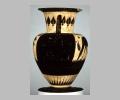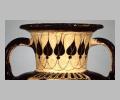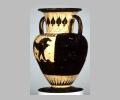| Collection: | University Museum, University of Pennsylvania |
| Summary: | Side A: lion |
| Ware: | Chalcidian Black Figure |
| Painter: | Attributed to the Group of the Phineus Cup |
| Context: | Said to be from Greek Islands |
| Date: | ca. 530 BC |
| Dimensions: | H. 0.241 m., D. rim 0.130 m., D. belly 0.161 m., D. base 0.094 m. |
| Primary Citation: | |
| Shape: | Neck amphora |
| Region: | Greece |
| Period: | High Archaic |
Condition:
Unpainted areas on the exterior of the vase are worn away leaving painted areas noticeably raised. Only a few small patches of original unpainted surface remain. The red paint has mostly flaked away.
Decoration Description:
Side A: lion. The lion strides to the right open-mouthed. Its tail is curved in a figure eight above its back, and there is a small rosette under its belly.
Side B: grazing deer. A doe faces left, head to the ground. There is an incised rosette under its belly and one over its neck.
The neck of the vase is decorated with interlocked lotus buds and flowers.
Shape Description:
Small neck amphora with echinus foot. There are fillets at the join of base to body and shoulder to neck.
Collection History:
The vase was collected by Tewfik Pasha, Khedive of Egypt. After his death it was sold in Constantinople. In 1896 it was purchased by H.V. Hilprecht for the University Museum, Philadelphia.
Sources Used:
Other Bibliography:





